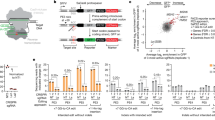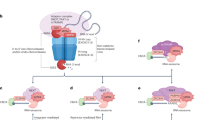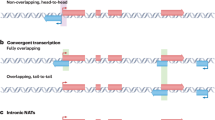Abstract
Primordial germ cells (PGCs) form during early embryogenesis with a supply of maternal mRNAs that contain shorter poly(A) tails. How translation of maternal mRNAs is regulated during PGC development remains elusive. Here we describe a small-molecule screen with zebrafish embryos that identified primordazine, a compound that selectively ablates PGCs. Primordazine’s effect on PGCs arises from translation repression through primordazine-response elements in the 3′ UTRs. Systematic dissection of primordazine’s mechanism of action revealed that translation of mRNAs during early embryogenesis occurs by two distinct pathways, depending on the length of their poly(A) tails. In addition to poly(A)-tail-dependent translation (PAT), early embryos perform poly(A)-tail-independent noncanonical translation (PAINT) via deadenylated 3′ UTRs. Primordazine inhibits PAINT without inhibiting PAT, an effect that was also observed in quiescent, but not proliferating, mammalian cells. These studies reveal that PAINT is an alternative form of translation in the early embryo and is indispensable for PGC maintenance.
This is a preview of subscription content, access via your institution
Access options
Access Nature and 54 other Nature Portfolio journals
Get Nature+, our best-value online-access subscription
$29.99 / 30 days
cancel any time
Subscribe to this journal
Receive 12 print issues and online access
$259.00 per year
only $21.58 per issue
Buy this article
- Purchase on Springer Link
- Instant access to full article PDF
Prices may be subject to local taxes which are calculated during checkout






Similar content being viewed by others
Data availability
The data that support the findings of this study including RNA-seq and proteomics analysis are available from the corresponding authors upon reasonable request.
Change history
26 July 2019
In the version of this article originally published, numbered compounds were not linked correctly to their respective compound pages. The error has been corrected in the HTML version of this paper.
References
Subtelny, A. O., Eichhorn, S. W., Chen, G. R., Sive, H. & Bartel, D. P. Poly(A)-tail profiling reveals an embryonic switch in translational control. Nature 508, 66–71 (2014).
Strome, S. & Updike, D. Specifying and protecting germ cell fate. Nat. Rev. Mol. Cell Biol. 16, 406–416 (2015).
Cai, H. et al. In vitro and in vivo differentiation of induced pluripotent stem cells into male germ cells. Biochem. Biophys. Res. Commun. 433, 286–291 (2013).
Geijsen, N. et al. Derivation of embryonic germ cells and male gametes from embryonic stem cells. Nature 427, 148–154 (2004).
Hayashi, K., Ohta, H., Kurimoto, K., Aramaki, S. & Saitou, M. Reconstitution of the mouse germ cell specification pathway in culture by pluripotent stem cells. Cell 146, 519–532 (2011).
Hayashi, K. et al. Offspring from oocytes derived from in vitro primordial germ cell-like cells in mice. Science 338, 971–975 (2012).
Park, T. S. et al. Derivation of primordial germ cells from human embryonic and induced pluripotent stem cells is significantly improved by coculture with human fetal gonadal cells. Stem Cells 27, 783–795 (2009).
Raz, E. Primordial germ-cell development: the zebrafish perspective. Nat. Rev. Genet. 4, 690–700 (2003).
Paksa, A. & Raz, E. Zebrafish germ cells: motility and guided migration. Curr. Opin. Cell Biol. 36, 80–85 (2015).
Winata, C. L. et al. Cytoplasmic polyadenylation-mediated translational control of maternal mRNAs directs maternal-to-zygotic transition. Development 145, dev159566 (2018).
Krøvel, A. V. & Olsen, L. C. Expression of a vas:EGFP transgene in primordial germ cells of the zebrafish. Mech. Dev. 116, 141–150 (2002).
Yoon, C., Kawakami, K. & Hopkins, N. Zebrafish vasa homologue RNA is localized to the cleavage planes of 2- and 4-cell-stage embryos and is expressed in the primordial germ cells. Development 124, 3157–3165 (1997).
Köprunner, M., Thisse, C., Thisse, B. & Raz, E. A zebrafish nanos-related gene is essential for the development of primordial germ cells. Genes Dev. 15, 2877–2885 (2001).
Weidinger, G. et al. dead end, a novel vertebrate germ plasm component, is required for zebrafish primordial germ cell migration and survival. Curr. Biol. 13, 1429–1434 (2003).
Dai, X., Jin, X., Chen, X., He, J. & Yin, Z. Sufficient numbers of early germ cells are essential for female sex development in zebrafish. PLoS One 10, e0117824 (2015).
Tzung, K.-W. et al. Early depletion of primordial germ cells in zebrafish promotes testis formation. Stem Cell Rep. 4, 61–73 (2015).
Siegfried, K. R. & Nüsslein-Volhard, C. Germ line control of female sex determination in zebrafish. Dev. Biol. 324, 277–287 (2008).
Slanchev, K., Stebler, J., de la Cueva-Méndez, G. & Raz, E. Development without germ cells: the role of the germ line in zebrafish sex differentiation. Proc. Natl. Acad. Sci. USA 102, 4074–4079 (2005).
Schulte-Merker, S. et al. Expression of zebrafish goosecoid and no tail gene products in wild-type and mutant no tail embryos. Development 120, 843–852 (1994).
Schulte-Merker, S., van Eeden, F. J., Halpern, M. E., Kimmel, C. B. & Nüsslein-Volhard, C. no tail (ntl) is the zebrafish homologue of the mouse T (Brachyury) gene. Development 120, 1009–1015 (1994).
Majumdar, A., Lun, K., Brand, M. & Drummond, I. A. Zebrafish no isthmus reveals a role forpax2.1 in tubule differentiation and patterning events in the pronephric primordia. Development 127, 2089–2098 (2000).
Giraldez, A. J. et al. Zebrafish MiR-430 promotes deadenylation and clearance of maternal mRNAs. Science 312, 75–79 (2006).
Mishima, Y. et al. Differential regulation of germline mRNAs in soma and germ cells by zebrafish miR-430. Curr. Biol. 16, 2135–2142 (2006).
Choudhuri, A., Maitra, U. & Evans, T. Translation initiation factor eIF3h targets specific transcripts to polysomes during embryogenesis. Proc. Natl. Acad. Sci. USA 110, 9818–9823 (2013).
Tischer, T., Hörmanseder, E. & Mayer, T. U. The APC/C inhibitor XErp1/Emi2 is essential for Xenopus early embryonic divisions. Science 338, 520–524 (2012).
Jackson, R. J., Hellen, C. U. T. & Pestova, T. V. The mechanism of eukaryotic translation initiation and principles of its regulation. Nat. Rev. Mol. Cell Biol. 11, 113–127 (2010).
Matoulkova, E., Michalova, E., Vojtesek, B. & Hrstka, R. The role of the 3′ untranslated region in post-transcriptional regulation of protein expression in mammalian cells. RNA Biol. 9, 563–576 (2012).
Hinnebusch, A. G., Ivanov, I. P. & Sonenberg, N. Translational control by 5′-untranslated regions of eukaryotic mRNAs. Science 352, 1413–1416 (2016).
Meijer, H. A. et al. Translational repression and eIF4A2 activity are critical for microRNA-mediated gene regulation. Science 340, 82–85 (2013).
Pestova, T. V. & Kolupaeva, V. G. The roles of individual eukaryotic translation initiation factors in ribosomal scanning and initiation codon selection. Genes Dev. 16, 2906–2922 (2002).
Silvera, D., Formenti, S. C. & Schneider, R. J. Translational control in cancer. Nat. Rev. Cancer 10, 254–266 (2010).
Mamane, Y., Petroulakis, E., LeBacquer, O. & Sonenberg, N. mTOR, translation initiation and cancer. Oncogene 25, 6416–6422 (2006).
Liu, Q. et al. Discovery of 9-(6-aminopyridin-3-yl)-1-(3-(trifluoromethyl)phenyl)benzo[h][1,6]naphthyridin-2(1H)-one (Torin2) as a potent, selective, and orally available mammalian target of rapamycin (mTOR) inhibitor for treatment of cancer. J. Med. Chem. 54, 1473–1480 (2011).
Marzluff, W. F., Wagner, E. J. & Duronio, R. J. Metabolism and regulation of canonical histone mRNAs: life without a poly(A) tail. Nat. Rev. Genet. 9, 843–854 (2008).
Tryon, R. C., Pisat, N., Johnson, S. L. & Dougherty, J. D. Development of translating ribosome affinity purification for zebrafish. genesis 51, 187–192 (2013).
Kedersha, N., Ivanov, P. & Anderson, P. Stress granules and cell signaling: more than just a passing phase? Trends Biochem. Sci. 38, 494–506 (2013).
Protter, D. S. W. & Parker, R. Principles and properties of stress granules. Trends Cell Biol. 26, 668–679 (2016).
Ramaswami, M., Taylor, J. P. & Parker, R. Altered ribostasis: RNA-protein granules in degenerative disorders. Cell 154, 727–736 (2013).
Strasser, M. J. et al. Control over the morphology and segregation of Zebrafish germ cell granules during embryonic development. BMC Dev. Biol. 8, 58 (2008).
Valcourt, J. R. et al. Staying alive: metabolic adaptations to quiescence. Cell Cycle 11, 1680–1696 (2012).
McKnight, J. N., Boerma, J. W., Breeden, L. L. & Tsukiyama, T. Global promoter targeting of a conserved lysine deacetylase for transcriptional shutoff during quiescence entry. Mol. Cell 59, 732–743 (2015).
Chen, J. et al. Genome-wide analysis of translation reveals a critical role for deleted in azoospermia-like (Dazl) at the oocyte-to-zygote transition. Genes Dev. 25, 755–766 (2011).
Belloc, E. & Méndez, R. A deadenylation negative feedback mechanism governs meiotic metaphase arrest. Nature 452, 1017–1021 (2008).
Pasternak, M., Pfender, S., Santhanam, B. & Schuh, M. The BTG4 and CAF1 complex prevents the spontaneous activation of eggs by deadenylating maternal mRNAs. Open Biol. 6, 160184 (2016).
Ivshina, M., Lasko, P. & Richter, J. D. Cytoplasmic polyadenylation element binding proteins in development, health, and disease. Annu. Rev. Cell Dev. Biol. 30, 393–415 (2014).
Siddiqui, N. U. et al. Genome-wide analysis of the maternal-to-zygotic transition in Drosophila primordial germ cells. Genome Biol. 13, R11 (2012).
Wu, H. et al. N-terminal domain of feline calicivirus (FCV) proteinase-polymerase contributes to the inhibition of host cell transcription. Viruses 8, 199 (2016).
Andreev, D. E. et al. Translation of 5′ leaders is pervasive in genes resistant to eIF2 repression. eLife 4, e03971 (2015).
Baird, T. D. et al. Selective mRNA translation during eIF2 phosphorylation induces expression of IBTKα. Mol. Biol. Cell 25, 1686–1697 (2014).
Richter, J. D. & Coller, J. Pausing on polyribosomes: make way for elongation in translational control. Cell 163, 292–300 (2015).
Schlueter, P. J., Sang, X., Duan, C. & Wood, A. W. Insulin-like growth factor receptor 1b is required for zebrafish primordial germ cell migration and survival. Dev. Biol. 305, 377–387 (2007).
Kramer, M. C. et al. Combinatorial control of Drosophila circular RNA expression by intronic repeats, hnRNPs, and SR proteins. Genes Dev. 29, 2168–2182 (2015).
Heiman, M. et al. A translational profiling approach for the molecular characterization of CNS cell types. Cell 135, 738–748 (2008).
Kopylova, E., Noé, L. & Touzet, H. SortMeRNA: fast and accurate filtering of ribosomal RNAs in metatranscriptomic data. Bioinformatics 28, 3211–3217 (2012).
Love, M. I., Huber, W. & Anders, S. Moderated estimation of fold change and dispersion for RNA-seq data with DESeq2. Genome Biol. 15, 550 (2014).
Robinson, M. D., McCarthy, D. J. & Smyth, G. K. edgeR: a bioconductor package for differential expression analysis of digital gene expression data. Bioinformatics 26, 139–140 (2010).
Link, V., Shevchenko, A. & Heisenberg, C.-P. Proteomics of early zebrafish embryos. BMC Dev. Biol. 6, 1 (2006).
Yoshigi, M., Pronovost, S. M. & Kadrmas, J. L. Interactions by 2D Gel Electrophoresis Overlap (iGEO): a novel high fidelity approach to identify constituents of protein complexes. Proteome Sci. 11, 21 (2013).
Sorrells, S., Toruno, C., Stewart, R. A. & Jette, C. Analysis of apoptosis in zebrafish embryos by whole-mount immunofluorescence to detect activated caspase 3. J. Vis. Exp. 2013, e51060 (2013).
van Ham, T. J., Mapes, J., Kokel, D. & Peterson, R. T. Live imaging of apoptotic cells in zebrafish. FASEB J. 24, 4336–4342 (2010).
Acknowledgements
We thank S. Vasudevan, T. Shioda, S. Lee, N. Dyson, W. Miles, and Y. Yu for discussions related to this manuscript. Thanks to K. Inoue (Kobe University, Japan), E. Raz (University of Münster, Germany), M. Bushell (MedicalResearch Council, UK), and J. Wilusz (University of Pennsylvania, USA) for providing plasmids. Thanks to U. Kim (next generation sequencing core at Massachusetts General Hospital) for help with the RNA-seq process, to A. Gonzales and D. Harrison for technical assistance, and to C. Reilly for chemical validation. Funding was provided by NIH grants 5T32HL007208-37 (Y.N.J.), R01GM088040 (R.T.P.), USDA grant 2014-07998 (R.T.P.), the Charles and Ann Sanders MGH Scholar Award (R.T.P.), and the L. S. Skaggs Presidential Endowed Chair (R.T.P.).
Author information
Authors and Affiliations
Contributions
Y.N.J., P.J.S., N.J.-Y., and R.T.P. designed the study and experiments. Y.N.J., P.J.S., N.J.-Y., and P.-Y.L. performed the experiments. Y.N.J. and P.J.S. performed data analysis. P.-Y.L. and Y.N.J. performed RNA-seq. Y.N.J. performed bioinformatics. S.J. synthesized chemicals. W.Y.H. and J.-R.J.Y. generated knockout fish. M.Y., S.-E.O., M.S., C.R.H., and S.A.C. contributed to 2D gel electrophoresis and proteomic analysis. Y.N.J. and R.T.P. wrote the paper. All authors commented on the manuscript.
Corresponding authors
Ethics declarations
Competing interests
P.J.S. and R.T.P. have applied for a patent for primordazine.
Additional information
Publisher’s note: Springer Nature remains neutral with regard to jurisdictional claims in published maps and institutional affiliations.
Supplementary information
Supplementary Text and Figures
Supplementary Figures 1–19, Supplementary Table 1
Rights and permissions
About this article
Cite this article
Jin, Y.N., Schlueter, P.J., Jurisch-Yaksi, N. et al. Noncanonical translation via deadenylated 3′ UTRs maintains primordial germ cells. Nat Chem Biol 14, 844–852 (2018). https://doi.org/10.1038/s41589-018-0098-0
Received:
Accepted:
Published:
Issue Date:
DOI: https://doi.org/10.1038/s41589-018-0098-0
This article is cited by
-
Retention of paternal DNA methylome in the developing zebrafish germline
Nature Communications (2019)
-
PAINTing translation
Nature Chemical Biology (2018)



